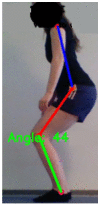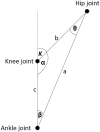The Potential of Computer Vision-Based Marker-Less Human Motion Analysis for Rehabilitation
- PMID: 34987303
- PMCID: PMC8492027
- DOI: 10.1177/11795727211022330
The Potential of Computer Vision-Based Marker-Less Human Motion Analysis for Rehabilitation
Abstract
Background: Several factors, including the aging population and the recent corona pandemic, have increased the need for cost effective, easy-to-use and reliable telerehabilitation services. Computer vision-based marker-less human pose estimation is a promising variant of telerehabilitation and is currently an intensive research topic. It has attracted significant interest for detailed motion analysis, as it does not need arrangement of external fiducials while capturing motion data from images. This is promising for rehabilitation applications, as they enable analysis and supervision of clients' exercises and reduce clients' need for visiting physiotherapists in person. However, development of a marker-less motion analysis system with precise accuracy for joint identification, joint angle measurements and advanced motion analysis is an open challenge.
Objectives: The main objective of this paper is to provide a critical overview of recent computer vision-based marker-less human pose estimation systems and their applicability for rehabilitation application. An overview of some existing marker-less rehabilitation applications is also provided.
Methods: This paper presents a critical review of recent computer vision-based marker-less human pose estimation systems with focus on their provided joint localization accuracy in comparison to physiotherapy requirements and ease of use. The accuracy, in terms of the capability to measure the knee angle, is analysed using simulation.
Results: Current pose estimation systems use 2D, 3D, multiple and single view-based techniques. The most promising techniques from a physiotherapy point of view are 3D marker-less pose estimation based on a single view as these can perform advanced motion analysis of the human body while only requiring a single camera and a computing device. Preliminary simulations reveal that some proposed systems already provide a sufficient accuracy for 2D joint angle estimations.
Conclusions: Even though test results of different applications for some proposed techniques are promising, more rigour testing is required for validating their accuracy before they can be widely adopted in advanced rehabilitation applications.
Keywords: Computer vision; marker-less; motion analysis; telerehabilitation.
© The Author(s) 2021.
Conflict of interest statement
Declaration of conflicting interests: The author(s) declared no potential conflicts of interest with respect to the research, authorship, and/or publication of this article.
Figures









References
-
- Helten T, Baak A, Müller M, Theobalt C. Full-body human motion capture from monocular depth images. In: Grzegorzek M, Theobalt C, Koch R, et al., eds. Time-of-Flight and Depth Imaging. Sensors, Algorithms, and Applications. Springer; 2013: 188-206.
-
- Pavlakos G, Zhu L, Zhou X, Daniilidis K. Learning to estimate 3D human pose and shape from a single color image. Paper presented at: 2018 IEEE/CVF Conference on Computer Vision and Pattern Recognition; 2018: 459-468; Salt Lake City, UT.
-
- Zhou H, Hu H. Human motion tracking for rehabilitation–a survey. Biomed Signal Process Control. 2008;3:1-18.
-
- Moeslund TB, Hilton A, Krüger V. A survey of advances in vision-based human motion capture and analysis. Comput Vis Image Underst. 2006;104:90-126.
Publication types
LinkOut - more resources
Full Text Sources

